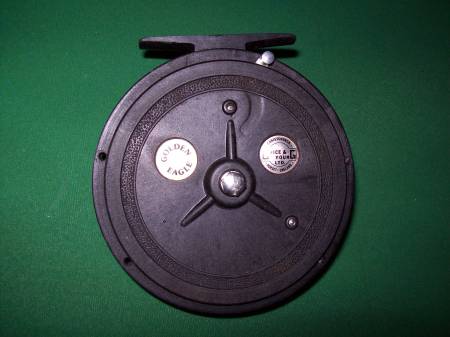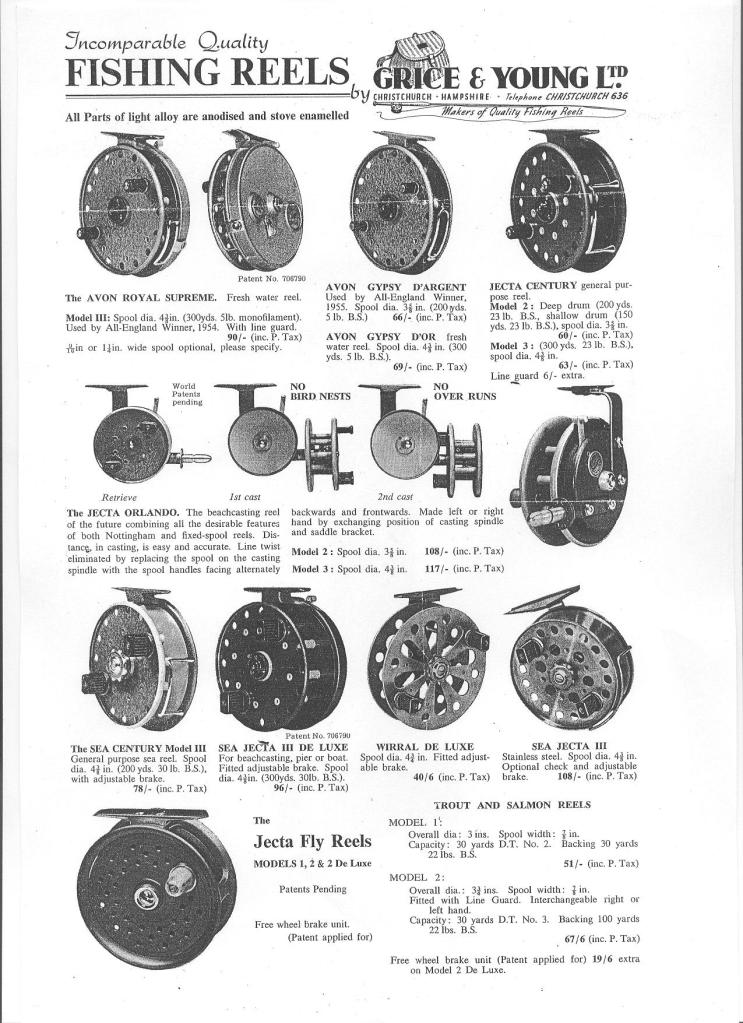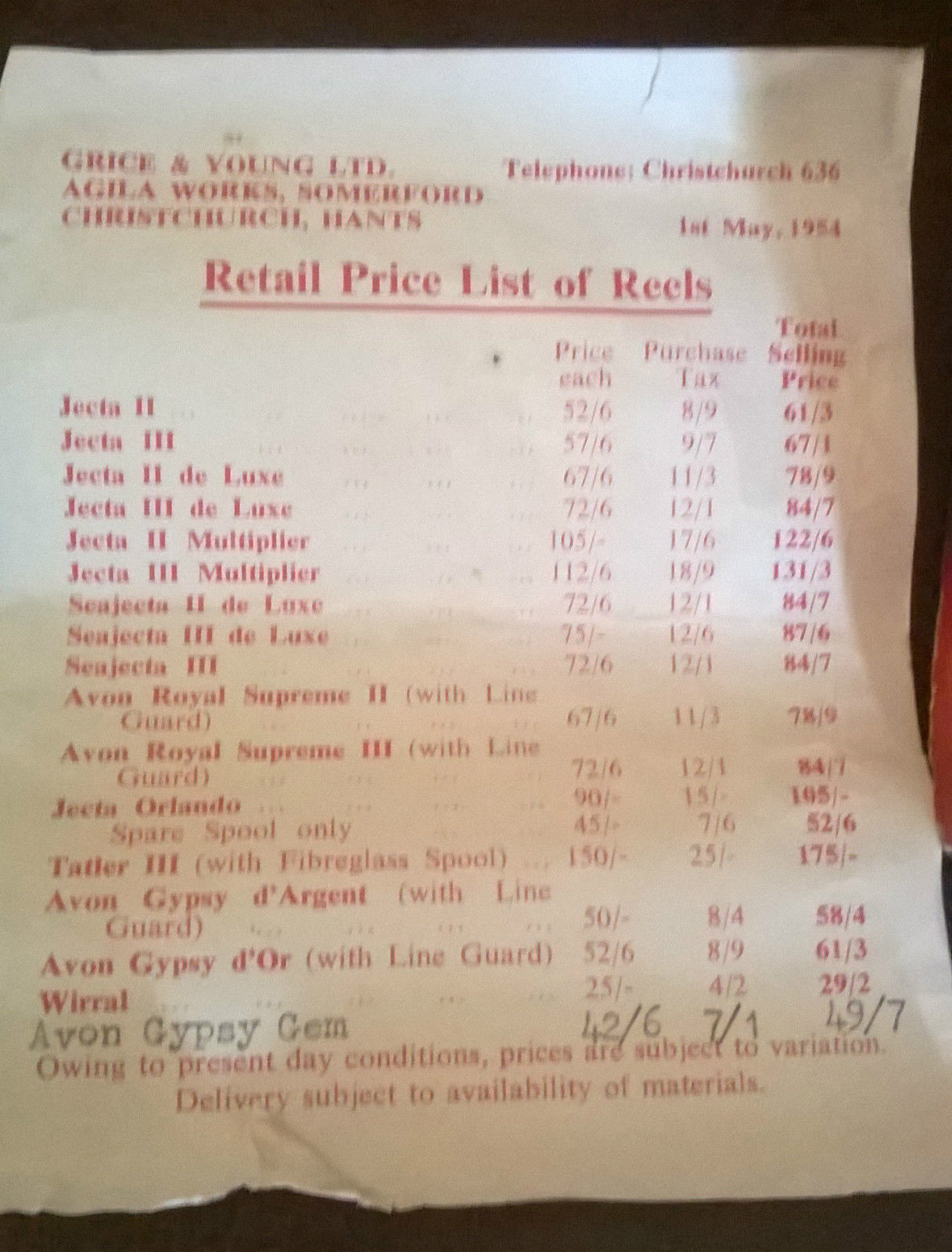Centrepin reels are an excellent choice for Luderick fishing as I have described in another article. One of my favourite manufacturers of centrepin reels, and indeed a favourite of Luderick anglers down the years, were Grice & Young.
These reels, although not designed for Australian conditions, are very handy luderick reels. They're hard wearing with a tough construction, few moving parts, yet a very small amount of force is needed to turn the spool. Sadly these reels are no longer manufactured in their original form, however, Shakespeare until recently sold a reel made with similar tooling to the original factory in the UK and there are many originals available via EBAY. If you want to buy from EBAY, it pays to know what to look for.
*WARNING FOR EBAYERS - Beware of over-inflated Buy-It-Now prices for G&Y reels. Sellers are currently (Nov13) starting reels off high and there have been some ludicrous Buy It Now prices. Also beware of reels that look refurbed but where the buyer doesn't state that this is the case. Most G&Y reels are painted, exception being a few Sea Jectas which were stainless, Avon Royals and Avon Crowns were NEVER sold in raw alloy, neither were Coq D'ors etc. Also beware of reels where the pillars look like they have been cleaned. There is nothing wrong with cleaned up or refurbed reels, but the sellers should state this explicitly in the description, especially where they are non-original.
The most common G&Y centrepin that you see on the rock platforms around NSW are the Avon Royal Supremes, Avon Crowns and the early Avon Royal MK3s. These reels were originally purchased as early as the 1950s and have been passed along as the original owners have passed away. As a result of the popularity of the Avon Royals, Australians usually name all G&Y reels Avon Royals, when in fact there were many model names and types. I have seen Grice & Young described as a "parts bin" company where they used whatever was at hand. I'm not so sure these days. After having seen hundreds of reels and analysed them, it is apparent that they regularly changed things. You can tell which period most reels are from by looking at the features and the furniture on the reels. The factory was in operation from around 1950 to 1980 and made many different models.
In truth there is little to choose between when selecting G&Y reels for luderick fishing. The appropriate reels are generally the reels which are 3.5inch or 4.5 inch and with a narrow spool (9/16 inch) and a shallow arbour, these are also the reels most appropriate for trotting a float in the UK, which is what most luderick fishing requires. Apart from the geometry, the only other variations are plastic vs metal, button operated ratchet vs lever operated ratchet, vented spool vs non-vented spool, presence or absence of drag mechanism and presence or absence of a lineguard.
Take the following example.
These two photos show the front and back of a Golden Eagle, this reel is probably from the late 70s, there are two versions that I have seen, one with the three way star pattern in the plastic backplate and one without, this is a progression from the all metal versions of the golden eagle that appeared in the early 70s
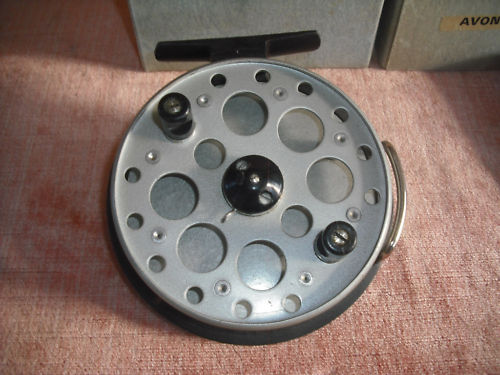
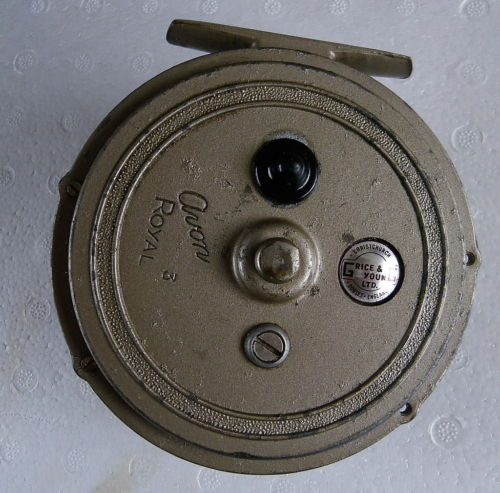 These two photos show the front and back of an Avon Royal 3 (the only indication being the marking on the box for 3) Later Avon Royals such as these have the plastic back and the vented spool that first appeared with the Golden Eagle. I am pretty sure these reels (and the all metal reel that preceded it) were never sold in the UK, only overseas particularly Australia. These reels were the last reels with Grice and Young badge and were from the early 1980s.
These two photos show the front and back of an Avon Royal 3 (the only indication being the marking on the box for 3) Later Avon Royals such as these have the plastic back and the vented spool that first appeared with the Golden Eagle. I am pretty sure these reels (and the all metal reel that preceded it) were never sold in the UK, only overseas particularly Australia. These reels were the last reels with Grice and Young badge and were from the early 1980s.
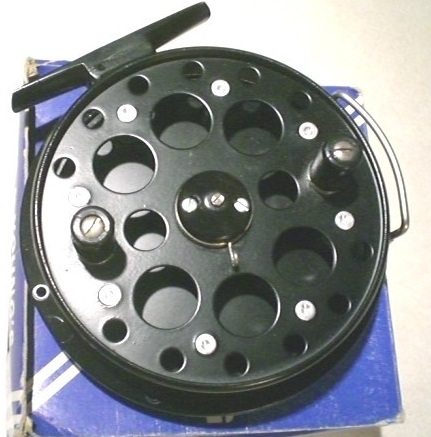
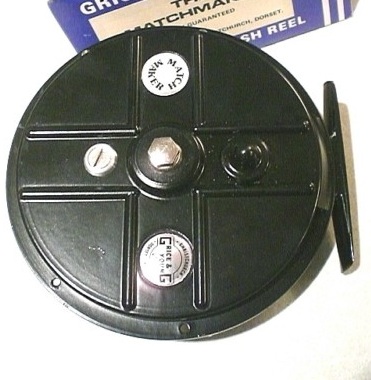
These two photos show the front and back of a MatchMaker. These reels were sold into the UK at the same time that the Avon Royal 3 above was being sold into Australia. These reels are from the early 1980s.
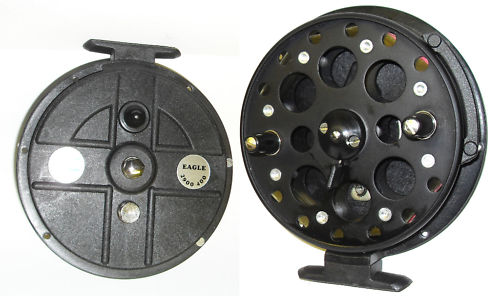
This photo shows the front and back of a Shakespeare Eagle 2900 400, These reels are still currently available. Although they don't have the G&Y badge, they are made with the same tooling that made the two reels above.
OK, so what's the point ? Well, these 4 reels are essentially the same reel. They are the same diameter, same spool depth, same spool construction, same backplate construction (synthetic non-metal). The only difference is that the first shown and the oldest in the progression has a different ratchet mechanism. My point is that model name is largely irrelevant. What is more relevant is the age, the construction (metal vs plastic), lineguard ( removeable vs non removeabel), presence or absence of a drag mechanism, type of ratchet mechanism and spool size ( diameter and depth). All of them are perfectly appropriate reels for luderick fishing yet only one of them bears the Avon Royal name.
An even better example is below. If you compare an all metal AvonRoyal 3 and a Gypsy D'or from the same period, you will find they are exactly the same with only the name changed. So if you are an avid luderick fisho looking for a lovely G&Y centrepin to use and maybe pass on to a son or daughter, then the Gypsy D'or in good nick is a good option.
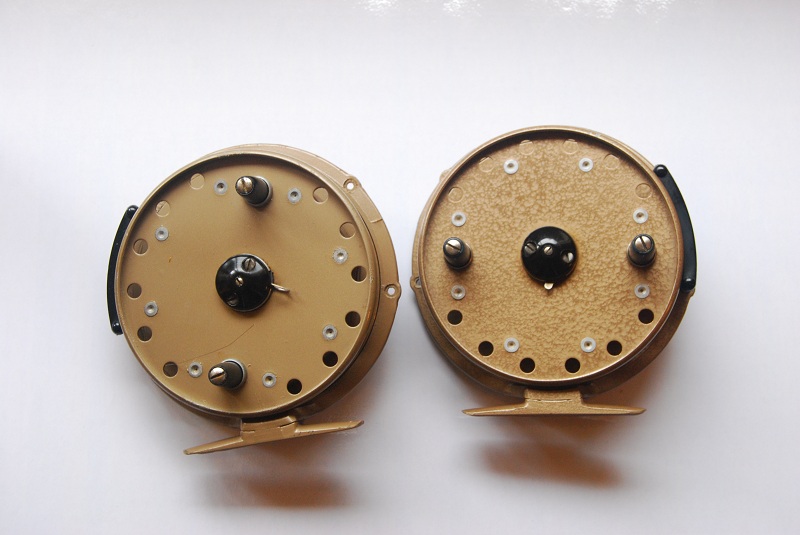
Avon Royal MK 3 from after 1974 on the left and a Gypsy D'or from around a similar time on the right. Apart from the paint they are identical.
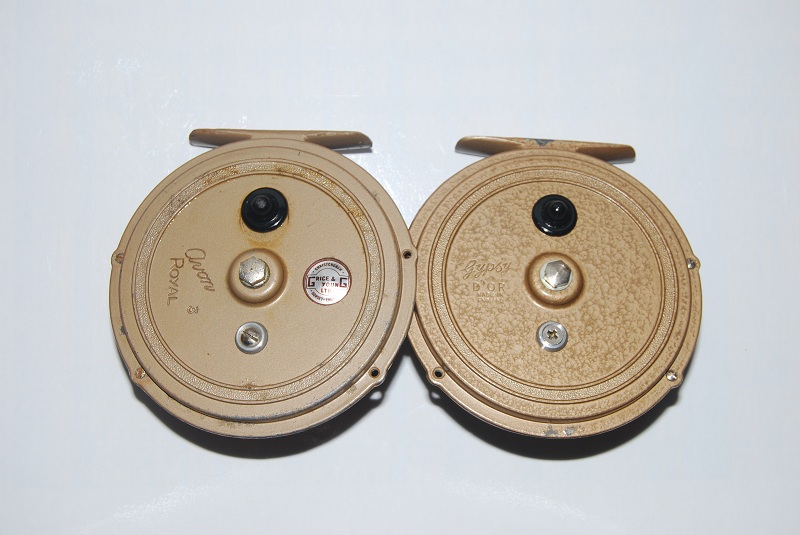
Two identical reels apart from the roundel on the Avon Royal MK 3 on the left. For some reason the Avon Royal MK 3 was only sold in Australia, whereas the Gypsy D'or was sold in the UK.
The Early Reels from 1947
Following you will see magazine scans from 1947 and 1948. These were posted by Andy Salter on the Traditional Fisherman's Forum. I had always thought that Grice & Young moved to Christchurch during the Second World War. Originally they made parts for motor vehicles and were located in Dunstable in Bedfordshire. Then they moved into undercarriages and parts for aircraft, including the Horsa gliders that were used in the prelude to D-Day. The gliders were assembled in Christchurch adjacent to the airfield. The earliest mention of Grice & Young reels are in these magazine advertisements, and prove that they were making reels as early as 1947, just after WW2.

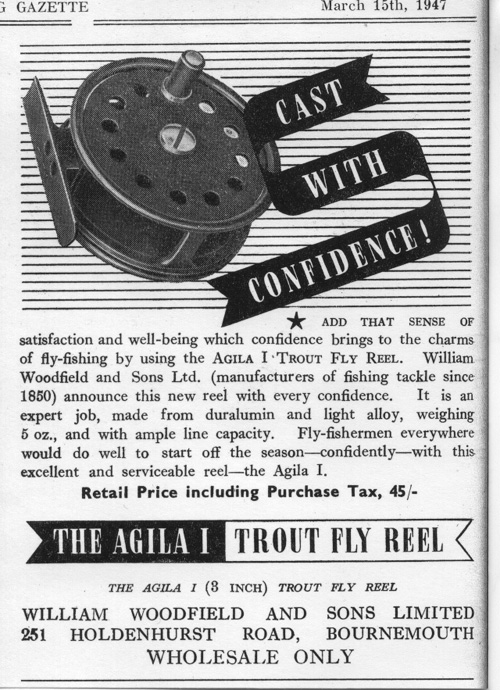
1950s Grice and Young Centrepins including the first incarnation of Avon Royal
Pre 1950s reels had a brass reel foot that was separate to the back plate of the centrepin. 1950-1964 the Grice & Young reels are characterised by ratchet mechanisms that are rivetted to the backplate, a centrepin that is incorporated into the backplate and not removeable, absence of any embossing on the backplate and a three screw centrepin cap.
Have a look at the following picture from a magazine circa 1955 and a price list from 1954
It's a great photo because it shows the reels that G&Y manufactured in the 1950s. Note that the spool caps have 3 screws, also that the G&Y brand is inscribed on the spool cap as shown in the next photo down. The price list is also interesting, shows the Gypsy Gem almost added as an afterthought.
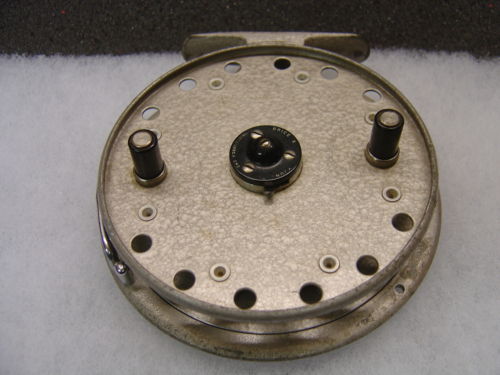
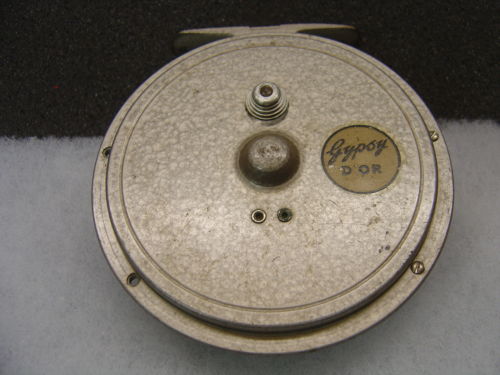
This set of photos clearly illustrates what the 1950s Gypsy D'or and Gypsy D'argent looked like. There is a clear absence of holes at the centre of the reel which I believe came later.
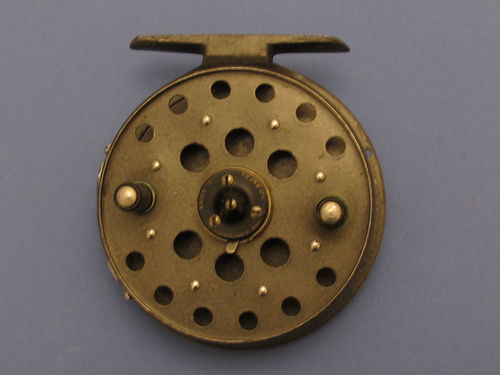
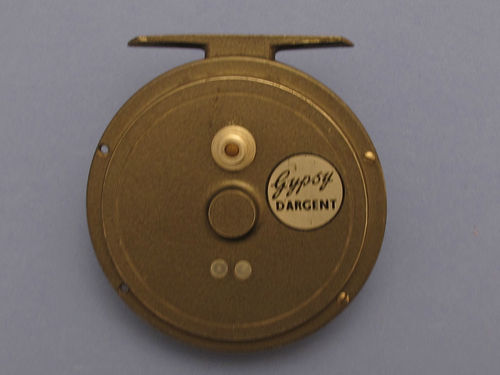
This reel is the Gypsy D'argent, probably slightly later model than the Gypsy D'or above.
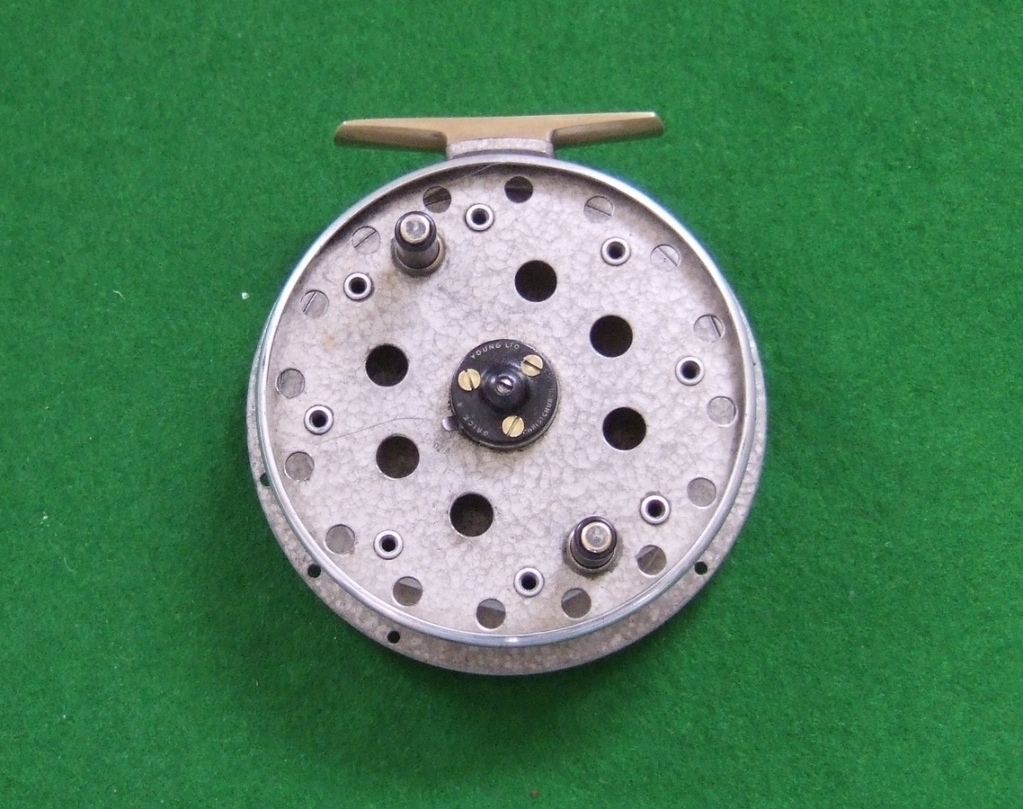
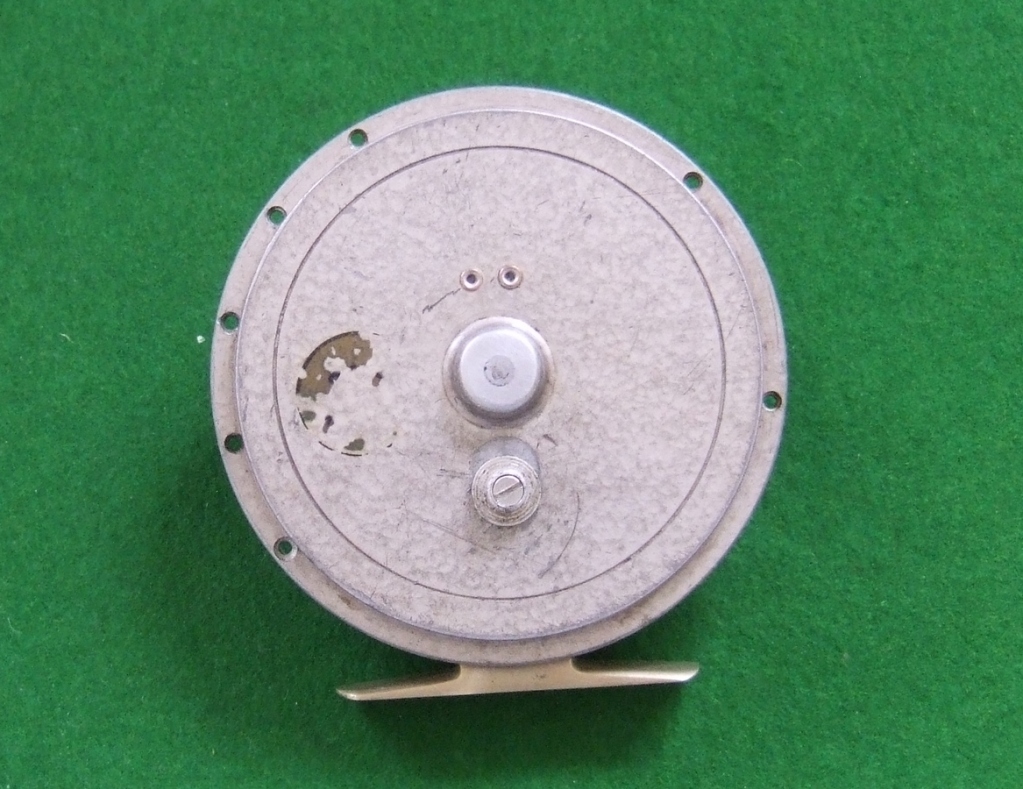
This reel is probably the same vintage as the Gypsy D'argent above. It is likely that there was a natural progression from these reels to the Avon Crown and the Avon Royal and the adding of a few extra holes from 6 to 8.
Although my research is far from complete, I believe that this type of model structure continued but with a change of names.
Premium Model Avon Royal Supreme 4 3/8" diameter and 9/16" and 1 1/4" inch spool depths with tension adjustment and ratchet lever
Standard Model Avon Gypsy D'argent 3 5/8" diameter narrow spool with ratchet button
Standard Model Avon Gypsy D'or 4 3/8" diameter narrow spool with ratchet button
Early 1960s Grice & Young Avon Royal, Avon Crown, Avon Crown Major, Avon Royal Superb and Avon Crown Superb
************ Please note I haven't yet worked out where the Avon Crown type sits, if you have a look at the 1961 price list following you will NOT see any of these reels, but it is possible that they were released between 1961 and 1965**************
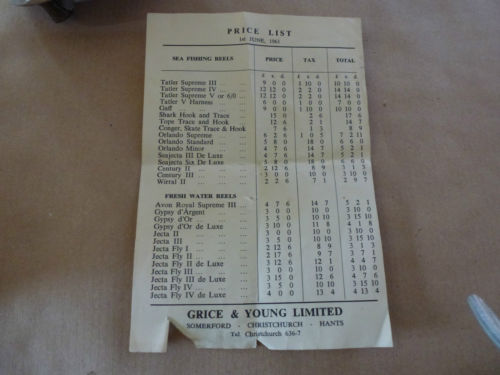
It seems that in the early 1960s, Grice & Young changed their manufacture slightly and marketed the Avon Gypsy, Avon Royal, the Avon Crown, and a new model of the Jecta, all characterised by a rim lever ratchet switch, riveted construction, fixed handles, coloured handle bases (green,blue,orange and red), fixed line guard and a different style of line pillar with a concave appearance. Model names were engraved and the reels generally finished in a painted grey enamel. The spools themselves characterised by 8 large symmetrical holes. At the time that these reels were available, the Avon Royal Supreme became the Avon Royal Superb when in its 3 3/4 inch size and the Avon Crown Superb when in its 4 1/2 inch size.
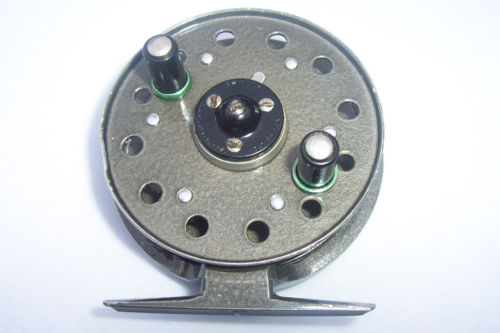
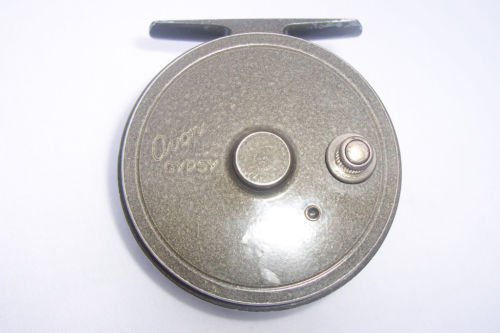
The 3 inch Avon gypsy had a button operated ratchet switch but operated from the side unlike all other button operated switches.
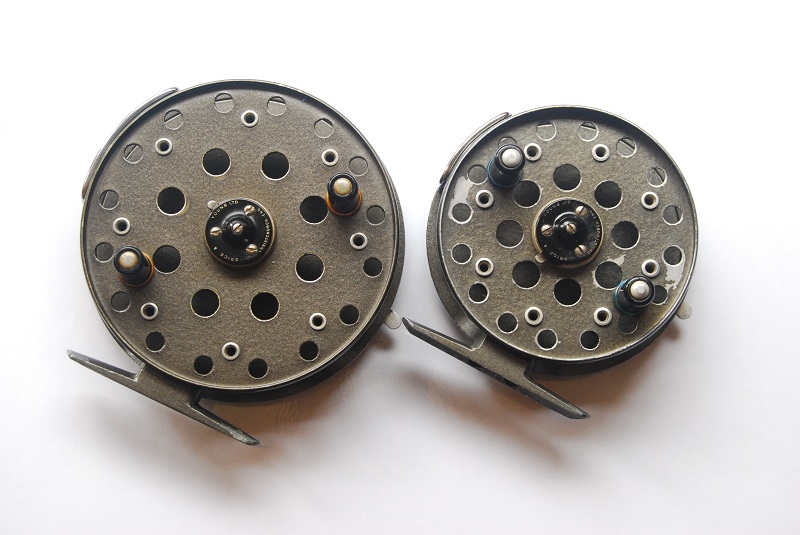
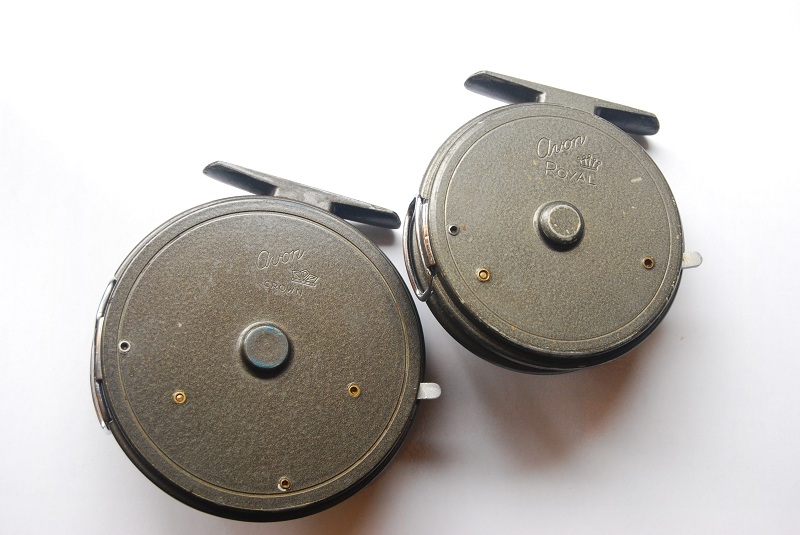
The Avon Crown and Avon Royal side by side

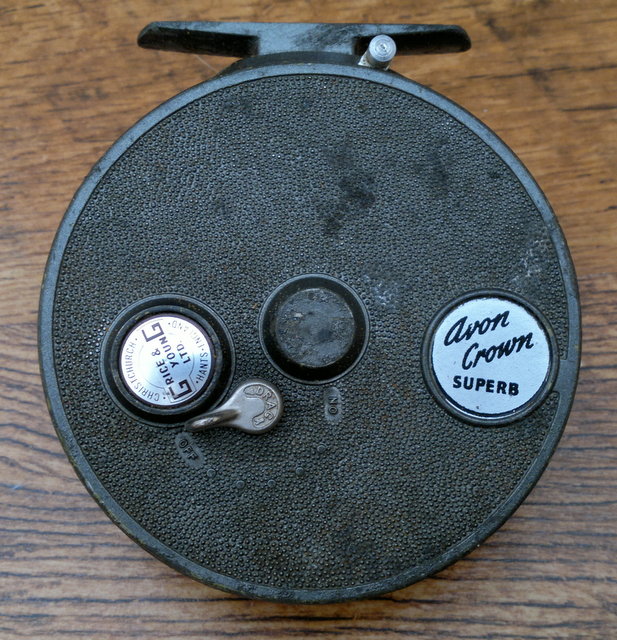
An Avon Crown Superb front and rear.
Another reel from the same period is the Avon Crown Major, which differs only in having a slightly larger arbour depth.
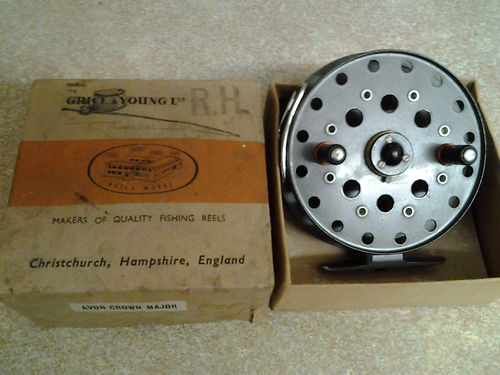
The small Avon Royal is a great reel for estuary blackfish and runs every bit as freely as the JW Youngs Trudex which is almost identical in size. It is nowhere near as nice a reel as the Trudex though, but simple and effective. The biggest downside of these reels is the riveted construction and the non-removeable lineguard. This means that your reel is effectively right handed or left handed depending on which side the guide is rivetted on. Same goes for the Crown.
A point to note is that the great majority of these reels were marketed for right hand winding (including the one pictured above), but it seems a small number were made for left hand winding. The left hand wind crowns are a rarity as are the royals.
In the photo below are two Avon Crowns, the one on the left for left hand wind, the one on the right for right hand wind.

On the upside, they are a very light and free running centrepin and relatively cheap if you want to pick one up from EBAY. Another upside is that the arbour isn't too deep, even on the Royal, with the posts on the same radius as the handles, which is good for both casting and retrieving.
Generally these reels are both excellent for luderick fishing provided you don't mind the lineguard, which could be removed by drilling out the rivet if you really wanted to. The Avon Royal being best for estuary and the Crown being better for the ocean rocks. I wouldn't bother with the Superb (as I wouldn't bother with the Supreme) for Australian situations, as the extra mechanism for the drag adds weight and complexity for no real gain.
The Crown weighs 270g and the Royal 175g. I have started using the Royal on a 10 foot rod and it is a delight to use, very light and very free running, probably the best of the smaller diameter reels.
Standard Models Early 1960s - 1974 (marked by circular embossing and absence of 3 screw cap)
Sometime in the early 60s G&Y reels appeared with a new design characterised by a cast alloy backplate with a circular embossed pattern. The first of these appeared with the older style 3 screw cap.

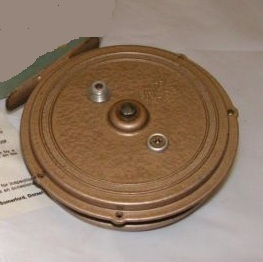
Photo is like one of those "missing link" fossils. Gypsy D'or with the characteristic 3 screw cap and ratchet switch of early models and the later paint style and embossing of later models, probably the first model after the discontinuation of the Avon Royal and Avon Crown.


This Photo shows the Gypsy D'argent from the same time period.
Pre 1974 reels are missing the roundel on the backplate that carries the G&Y name and Christchurch,Dorset England. As far as I can tell models betwen these times carry on the tradition of engraving the name into the backplate for the earlier models and the names of Gypsy Dargent and Gypsy D'or continued along with the sizes. Some time during the 60s, the circular embossing became standard and everything became removeable, handles could be unscrewed as well as the centrepin intself, as could the ratchet mechanism.
As well as the cast backplate with the circular embossing, it looks like they settled on a common backplate for all models, ie Gypsy D'or, Avon Royal 3 and Golden Eagle, they just drilled holes for the screws or roundels in different positions. Have a look at the photos below that have a Gypsy D'or backplate next to a Golden Eagle backplate, the piece of cast metal that holds the spring in place in the Eagle is ther in the D'or but unused as it is in the Avon Royal 3.
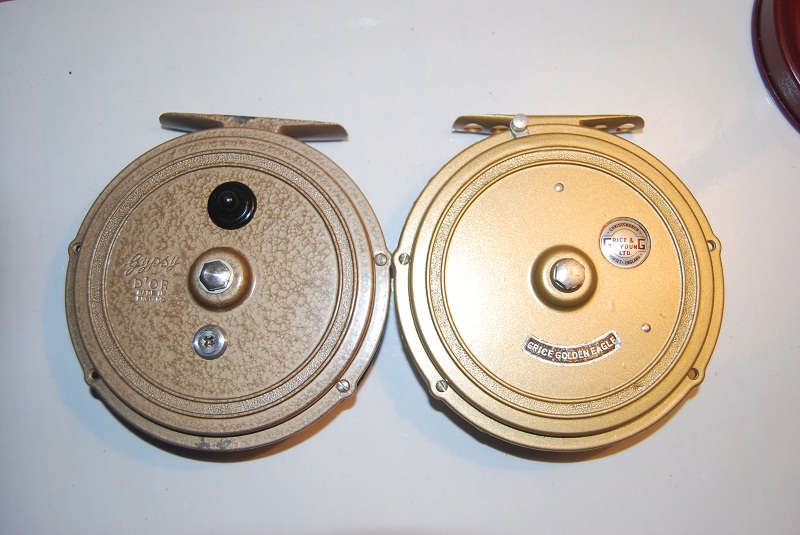

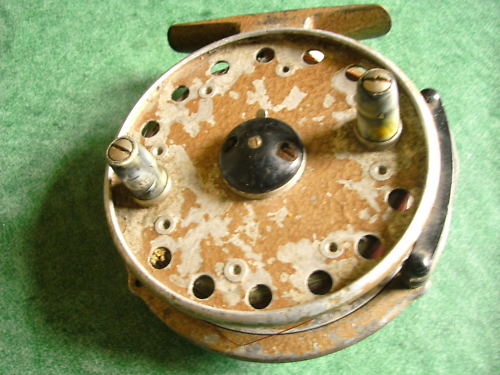
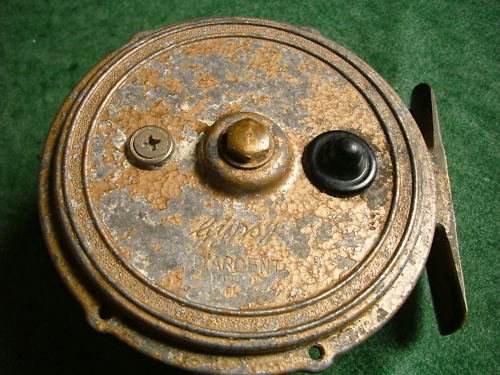
Gypsy Dargent mid 1960s onwards 2 screw endcap 3.5 inch with engraving also note the start of the circular embossing on backplate.
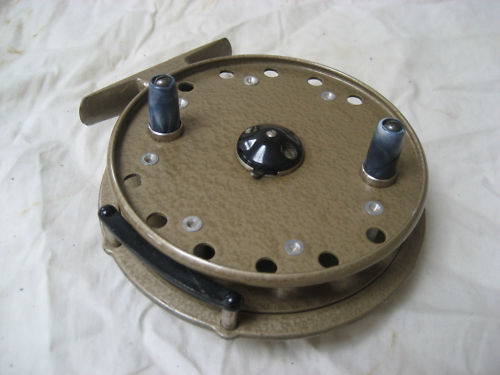
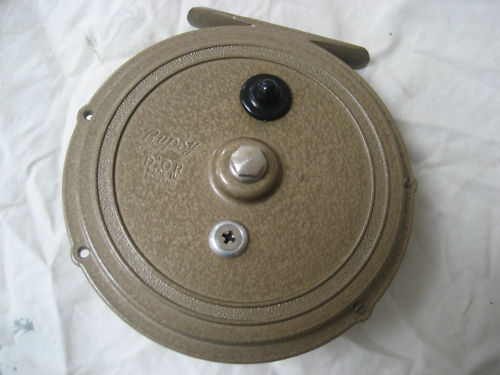
Gypsy D'or mid 1960s onwards 2 screw endcap 4.25 inch with engraving and the circular embossing on backplate.
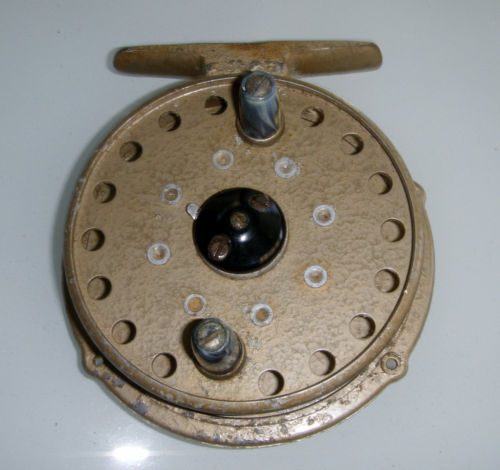
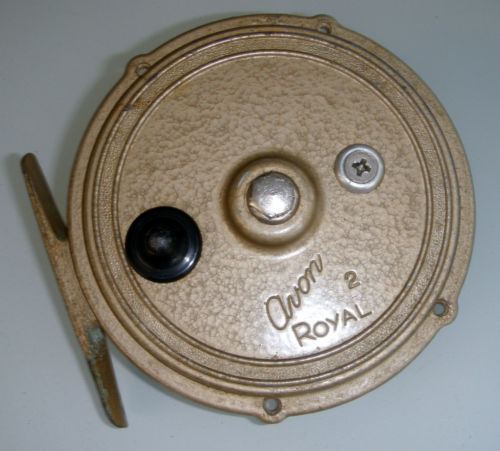
Photo is of Avon Royal 2 in the 3.5 inch which were sold into Australia and possibly other countries
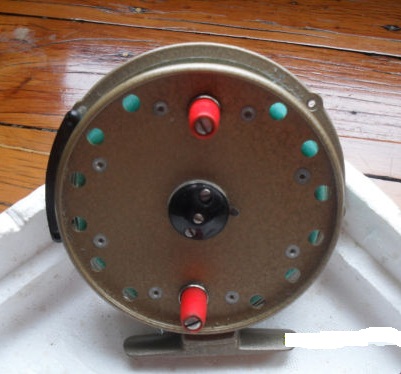
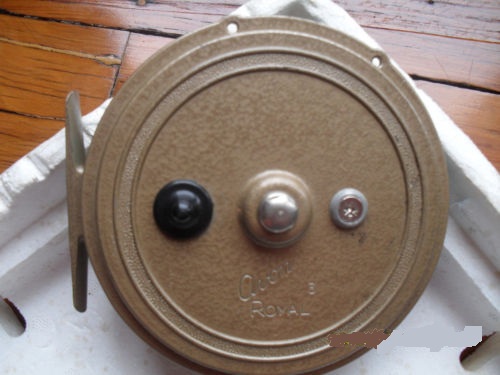
Photo is of an Avon Royal 3 which marks the first time that the Avon Royal was seen in a 4.5 inch model and was marketed into Australia.
At some time later than the model above model G&Y decided to reintroduce a rim ratchet switch model. They also started to include a roundel. I believe that this was just before the county changed to Dorset from Hants. I think this was also athe time that the Golden Eagle was introduced. Have a look at the following photo.
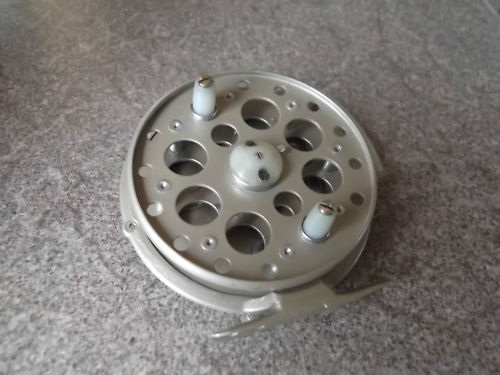
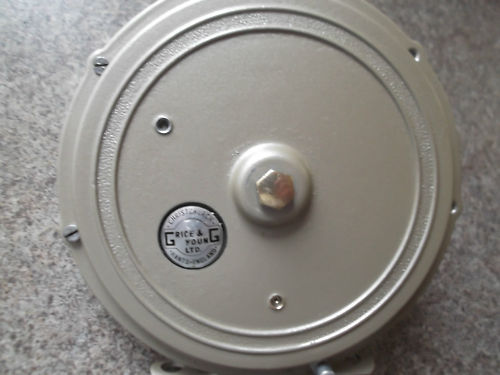
Note the roundel with the Hants marking, the characteristic vented spool of the golden eagle, foot with drilled holes and rim ratchet switch near foot.
Again I have no real proof, but I believe the Golden Eagle range began with the above reel.
Standard Models between 1974 and factory close circa 1983
This period is dominated by the Golden Eagle which morphed from the one show above, into one exactly the same only with the roundel up side down and marked with Dorset rather than Hants after the city of Christchurch changed counties.
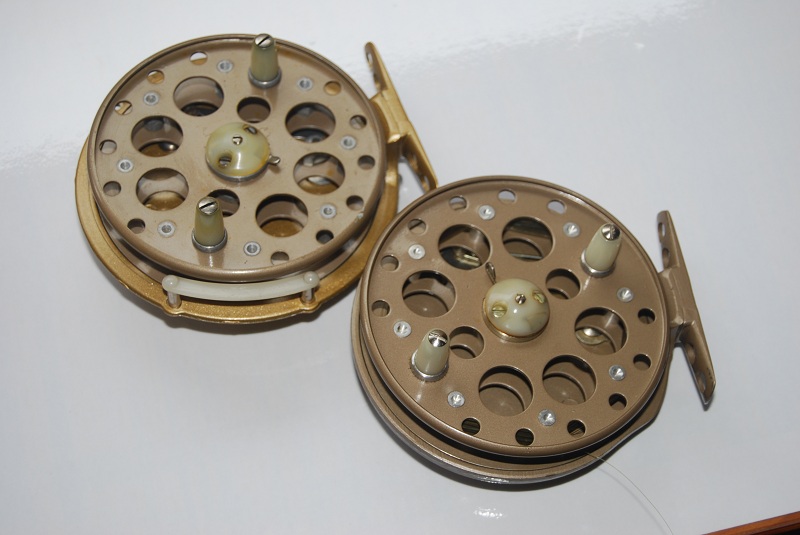
Post 1974 Grice Golden Eagle on the left and its little brother the Grice Coq D'or which is different only in respect of the absence of the lineguard and the metal therfore that the line guard sits on. This makes it slightly lighter and slightly smaller, although the spool is exactly the same on both.
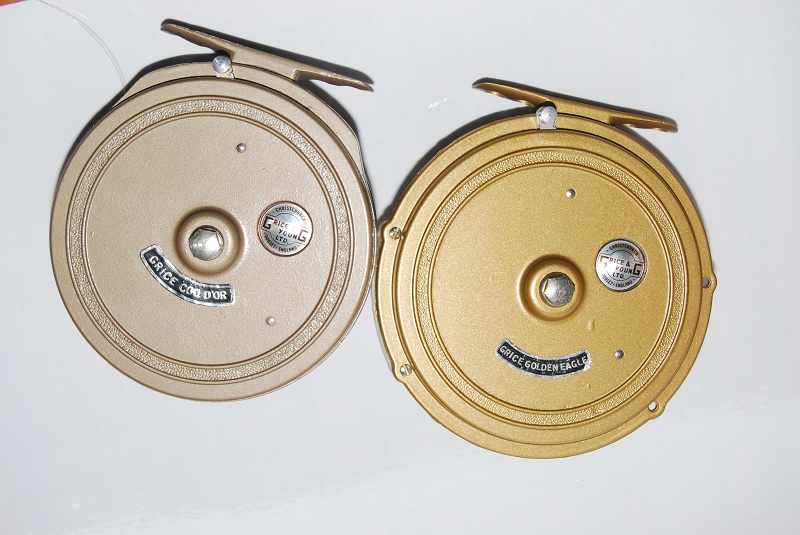
The rear of the Grice golden Eagle and the Grice Coq D'or, both excellent. The one on the right is only that lovely gold because it is one I refurbed, they are usually in that ugly beige of the left hand reel. The worst thing about these reels is the horrible model sticker, most that you see are absent of the sticker, not surprisingly. The Grice Coq D'or is an excellent reel for blackfish, especially as it doesn't have the lineguard which I don't really favour anyway.
The Avon Royal 3 was continued as well with its button operated ratchet.
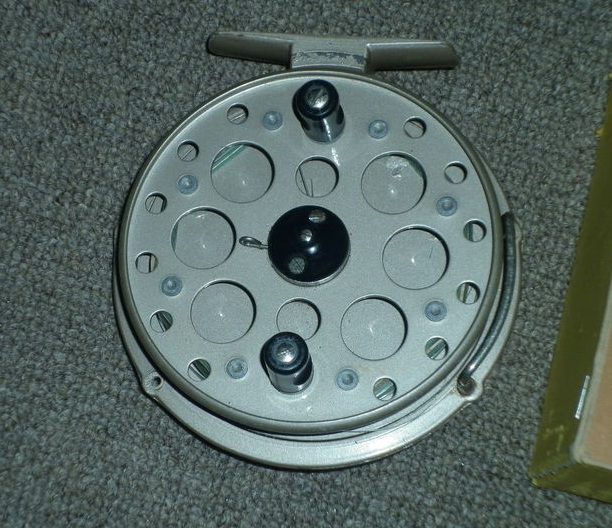
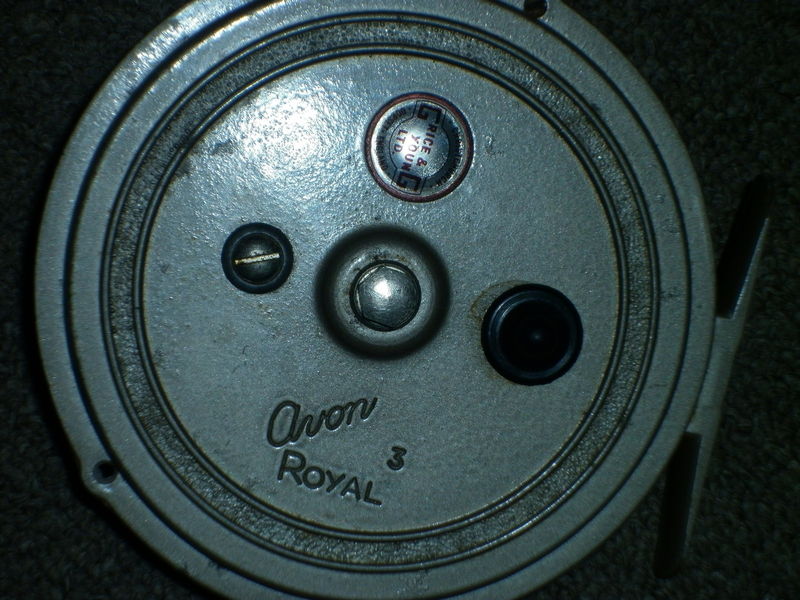
Photos are of the Avon Royal 3 post 1974 Using the roundel with Dorset and the characteristic Golden Eagle style spool
At some time the Golden Eagle and Avon Royal 3 were all manufactured with a polycarbonate backplate as can be seen above in the first set of photos. When the factory closed, the tooling for the Avon Royal 3 was turned over to Shakespeare who made the Shakespeare Eagle 2900 400 and 2900 600
(It seems that on further examination, manufacture of the reels was relocated to the Isle of Wight and a company called Cresselle Ltd. Some time after, the tooling was turned over to a company in South Africa, the reels as far as I know are still made there and produced for Shakespeare Etc)
Continuity of the the Premium Avon Royal Supreme model until factory close circa 1980
One constant from 1954 until the close of the factory in the 1980s, appears to be the Avon Royal Supreme. This is the most common type available on EBAY and I think this is mainly because the model was consistent in its naming and form. The Avon Royal Supreme features a ratchet with a spool rim mounted switch AND an adjustable check. There are a number of different colour schemes, line guard types and spool depths and widths. The latest models featured a moulded plastic back plate. Any of these reels are appropriate for luderick fishing in Australia, but I would stick to the larger diameter and the narrow spool, ie 4 3/8 inch by 9/16 inch. In the next series of pictures I attempt to give a visual of the progression over time.

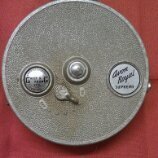
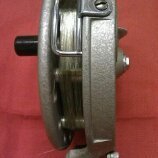
1950s Avon Royal Supreme note black pointed cap and line guard with single mount point also hammertite finish
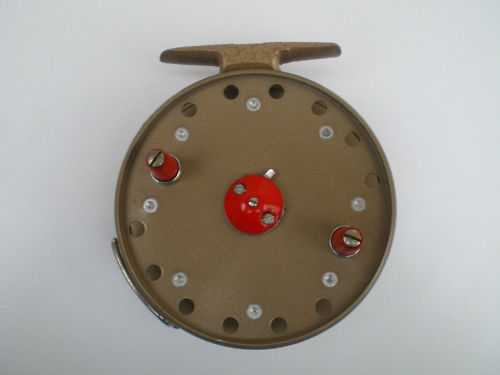
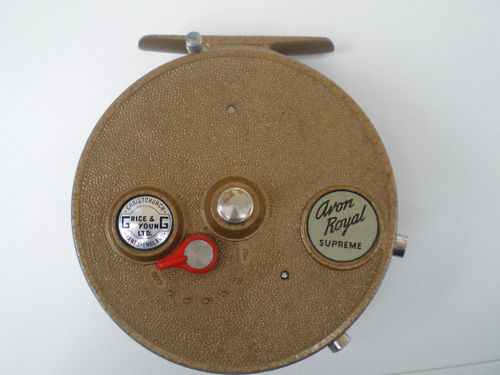
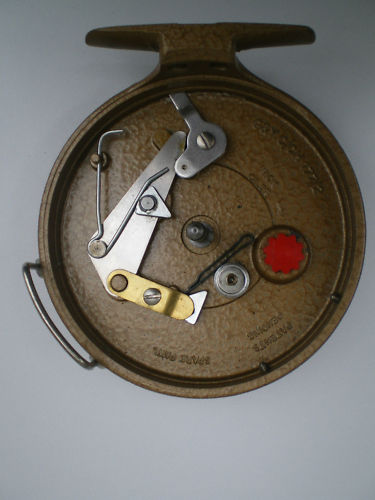
1960s Avon Royal Supreme note the cap with 2 screws and line guard with dual mount point and "gold" finish, also Hants marked on the roundel
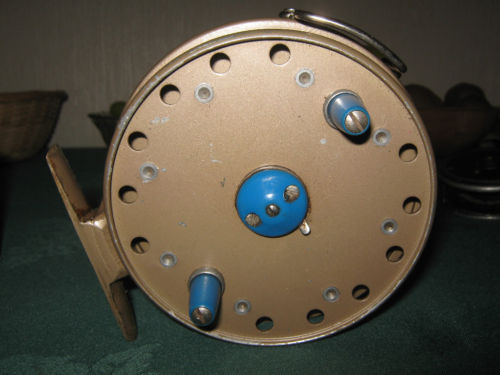
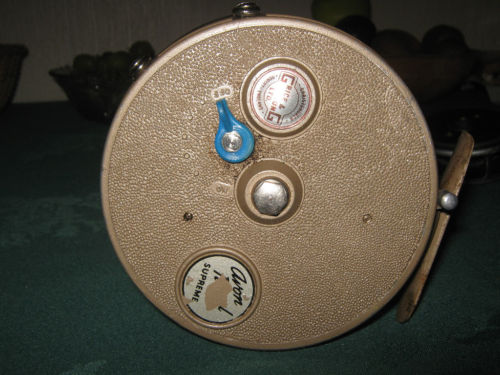
This lovely blue handled version has got the Dorset marking on the roundel which places it as post 1974
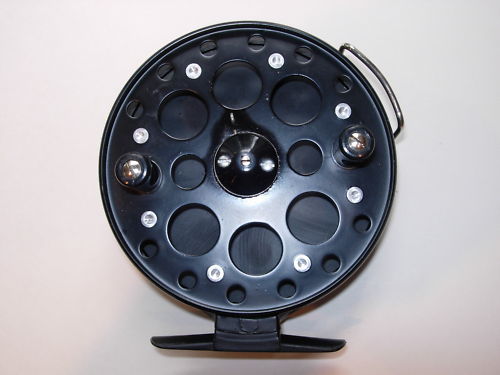
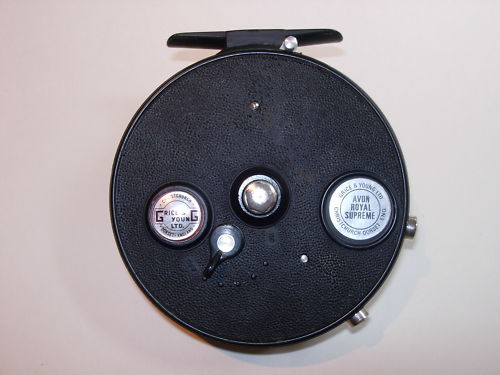
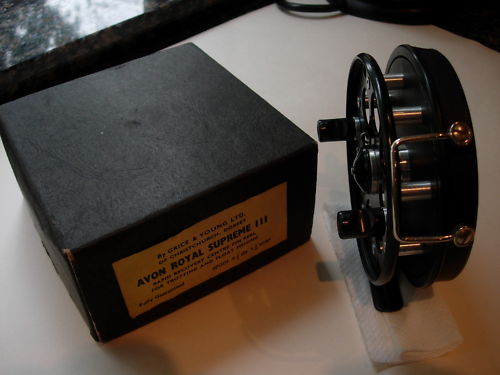

Later than 1974 and the last model, note the black finish, the elaborate model label, drilled spool face, plastic moulded backplate. I now know for a fact that these were available as recently as 1983.
I think these four sets of photos tell a very useful story. Firstly this model was so good and so successful that it remained largely unchanged for 25 years and remains a good reel today. The middle reel with the red handles is mine, bought from EBAY for GBP70 and is absolutely in mint condition without a box. Generally these reels fetch around GBP100 for a mint condition unit with its original box. A decent condition reel can be anywhere between GBP30 and GBP50, which means that you can pick up a very very good luderick reel for around AUD100 delivered.
Avon Royal Supreme Variations
Grice & Young marketed variations of the Avon Royal Supreme with different names. The most notable of these appeared at the same time that the Avon Crown and Avon Royal were marketed, were called the Avon Crown Superb and Avon Royal Superb, and more details can be found in this review here .
Late in the 1970s they also marketed a 3.5 inch plastic backed version of the Avon Royal Supreme and called it the Avon Royal Eagle. This reel is characterised by having no lineguard and a distinctive blue label. It has a lever operated check and adjustable drag. The reel pictured was purchased in 1977, big thanks to Mark from British Columbia for the photos and information.
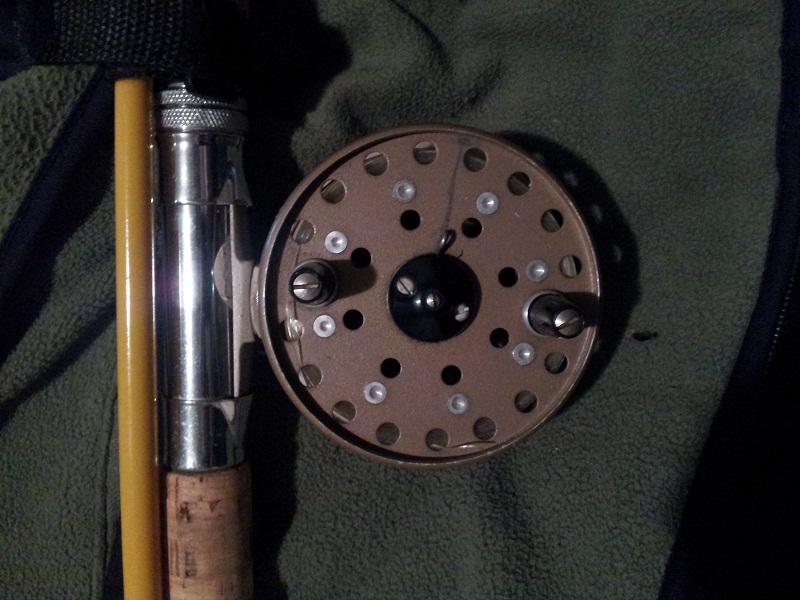

A Random Collection of useful things to know and some questions
So, why are there so many other reels that G&Y made and what are they for ? For example there is the Jecta, the Century, the Big Piker ! yikes. Many of them are for sea fishing and have deep spools and deep arbours so that plenty of line can be packed on to them. You can tell these by looking at the placings of the arbour posts, also some have a simple drag screw on the spindle.
It seems that the Avon Royal MK2 and MK3s were not available in the UK, in the UK they retained the Gypsy D'or and Gypsy D'argent instead. If anyone could confirm this thought please do. I have never seen one on EBAY from UK, but often see them come up in Australia. Additionally you rarely see a Gypsy D'or in Australia, certainly not pre EBAY.
G&Y reels come in 3 sizes. These are usually marked as Model 1, Model 11, Model 111 etc, or MK1 MK2 MK3 etc. So, the Avon Royal Supreme 3 is called that because of its size ie 4.5 inch not because there were 2 different versions before it.
Similarly the Avon Royal MK2 is 3.5 inch whereas the MK3 is 4.5 inch.
Sometimes G&Y gave different sizes in the same series different names like Gypsy D'or for 4.5 inch and Gypsy D'argent for 3.5 inch, another example the 1960s Avon Royal at 3.5 inch and the Avon Crown at 4.5 inch.
The Grice in Grice & Young was Joseph Brindley Gurney Grice , and the Young was Charles Edwin Young. I believe that they originally started out as Motor Equipment Engineers, perhaps in Dunstable Bedfordshire. JBG Grice or Gurney as he was known has his name on a number of patents which are viewable on the internet. Most notable are his patent for the drag, oiler wick and spare pawl in the Avon Royal Supreme and the mechanism for the Orlando which if you care is viewable by searching for GB706790 and US2783001
I love the fact that someone engineered these things simply and soundly to last across generations. Any body who would like to add to the story of G&Y please contact me through the comments function.
I found this brochure photo with a photo of the factory. The factory was called the Agila Works and was located on Somerford Road in Christchurch. Also thanks to the folks at the Christchurch Historical Society I was sent this map which shows where the factory was located.
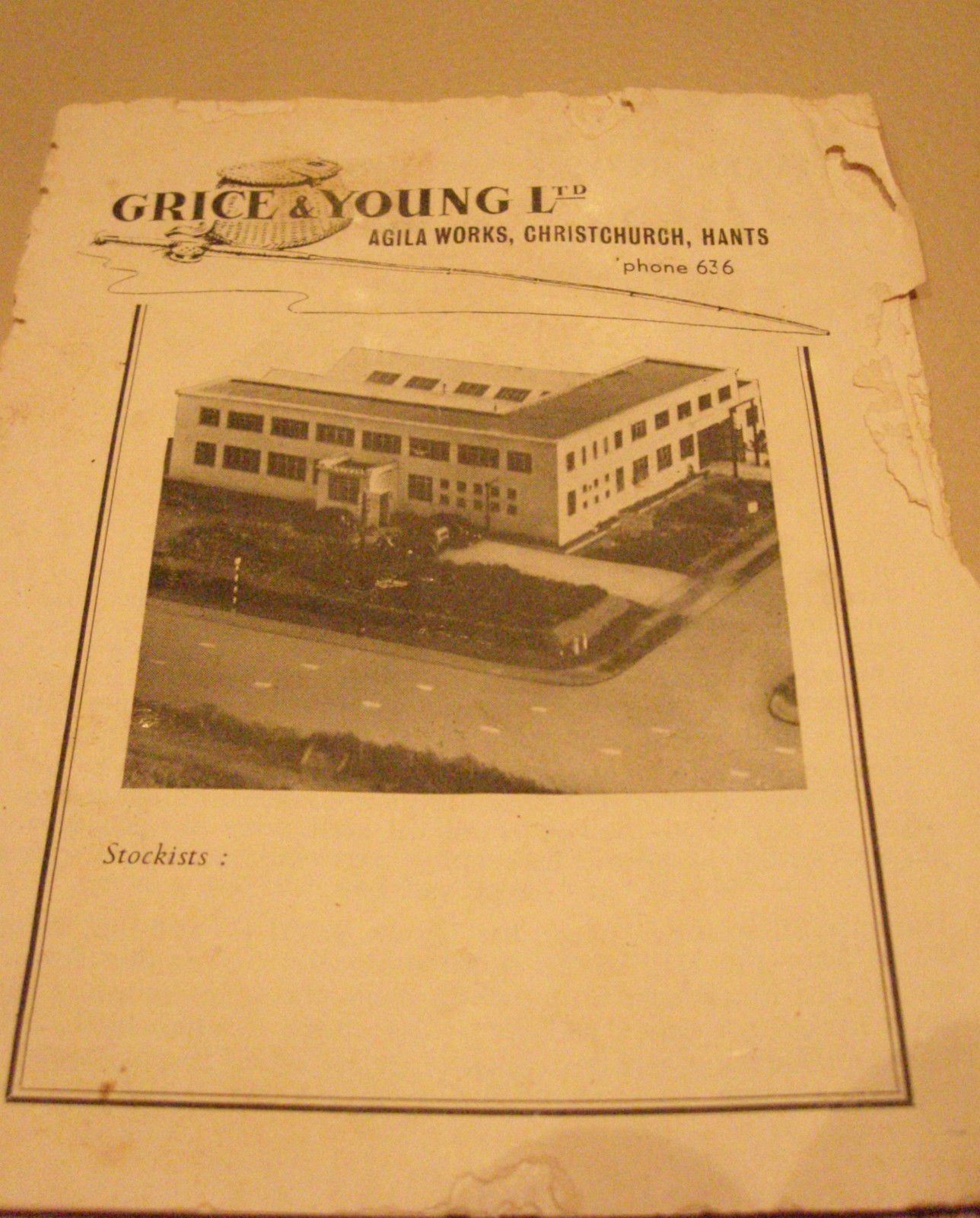
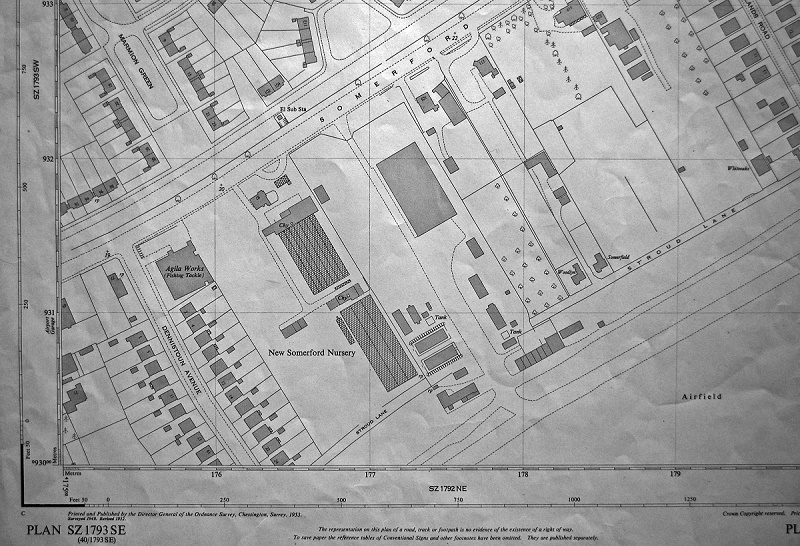
Summary and Recommendations
Most of the reels that have been featured above are good luderick reels. In my opinion the larger reels are the best ie the 4.5 inch models. Stick to spool depths of 0.5 inch, you have to be careful as there are plenty of 1 inch spools available in some of the models. You can tell a lot from photos and if the surface of the reel is in good condition, chances are the bushes and ratchet will be OK. The one question you need to ask a seller is whether there is any wobble in the spool. This is the critical point as to whether the reel is beyond use or not.
I recently purchased a very dodgy looking reel from the UK, it was obvious from the photos that it was in poor condition, but I took a punt and won the auction at GBP 8 plus 6 postage. When the reel arrived it was exactly as photographed and described. The spool wouldn't spin and the backplate was badly paint affected. The spool itself didn't actually look too bad. I stripped it down and removed all of the screws and ratchet mechanism. Slowly removed the spool and soaked it in bicarbonate of soda for a while, gave it a scrub and cleaned all of the corrosion off the arbour posts. Cleaned the bush with a pipe cleaner. Then I paint stripped the backplate, etch primed it and gave it a couple of coats of satin black. When I had cleaned off all the mechanism and put the reel back together and oiled, the results were astounding. The reel had no wobble whatsoever and really came up beautifully with a lovely free spinning action.
The point is that these reels are very hard to kill and I wouldn't hesitate in picking up further reels for refurbishing. There are plenty of ready to use reels that come up for auction and you can pick these up for GBP30-60. Then there are the mint without original box for around GBP60-90 and the mint with original box for around GBP90-140. Obviously prices depend on models and condition.
If I had to rate the top 5 G&Y reels for Australian conditions they would be (Reviewed as of Jan 2013 after further field use evaluation)
1. Plastic backed models, Avon Royal 3, Matchmaker, Grice Golden Eagle from late 70s with the polycarbonate backplate. These are rated highly as they are hard wearing and light, they have all of the great characteristics of the early reels as well.
2. Avon Royal 3 or Gypsy D'or post 1960 - Avon Royal 3 goes for anywhere between AUD150-250 in Australia yet you can pick up a good Gypsy D'or for around GBP60
3. Avon Crown and Avon Royal depending on which size you want, lose some points due to the nature of the fixed line guard.
4. Grice Coq D'or - Difficult to find and a good one without its box will cost around GBP70
5. Avon Royal Supreme - Very easy to pick up but a bit heavy for luderick generally, good one for around GBP70 without box.
I hope this article is useful to you and the information within as correct as possible. If you find something to be inaccurate then please let me know through the contact form interface. There are things I'm not happy with in my chronology and would like anyone with more information to help out if possible. I suspect I will be making many edits of this over time.
{pdf=http://www.macman.id.au/images/stories/GYTable.pdf|100%|300|native}
{jcomments on}


